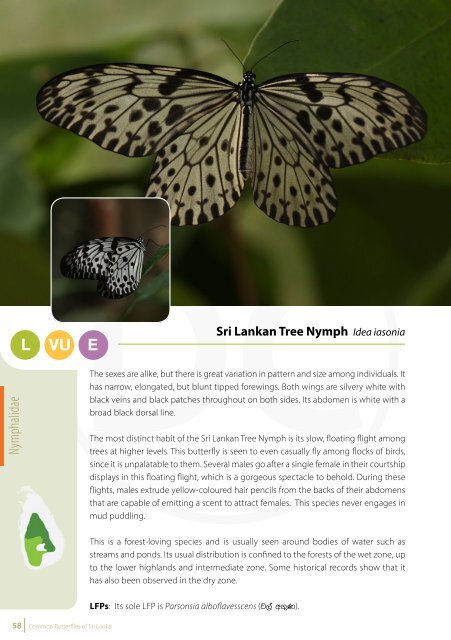Common Butterflies of Sri Lanka
Common Butterflies of Sri Lanka
Common Butterflies of Sri Lanka
Create successful ePaper yourself
Turn your PDF publications into a flip-book with our unique Google optimized e-Paper software.
<strong>Sri</strong> <strong>Lanka</strong>n Tree Nymph Idea iasonia<br />
Blue Glassy Tiger Ideopsis similis<br />
L VU E<br />
M VU<br />
Nymphalidae<br />
The sexes are alike, but there is great variation in pattern and size among individuals. It<br />
has narrow, elongated, but blunt tipped forewings. Both wings are silvery white with<br />
black veins and black patches throughout on both sides. Its abdomen is white with a<br />
broad black dorsal line.<br />
The most distinct habit <strong>of</strong> the <strong>Sri</strong> <strong>Lanka</strong>n Tree Nymph is its slow, floating flight among<br />
trees at higher levels. This butterfly is seen to even casually fly among flocks <strong>of</strong> birds,<br />
since it is unpalatable to them. Several males go after a single female in their courtship<br />
displays in this floating flight, which is a gorgeous spectacle to behold. During these<br />
flights, males extrude yellow-coloured hair pencils from the backs <strong>of</strong> their abdomens<br />
that are capable <strong>of</strong> emitting a scent to attract females. This species never engages in<br />
mud puddling.<br />
This is a forest-loving species and is usually seen around bodies <strong>of</strong> water such as<br />
streams and ponds. Its usual distribution is confined to the forests <strong>of</strong> the wet zone, up<br />
to the lower highlands and intermediate zone. Some historical records show that it<br />
has also been observed in the dry zone.<br />
The sexes are alike. The background colour on the upper surface <strong>of</strong> its wings is black,<br />
while the underside is brown. The markings on its forewing are blue, while those on<br />
its hind wing are glass white. The differences in these colours are prominent on the<br />
underside. These markings are similar in shape on both the upper and lower surfaces.<br />
Its forewing cell has a basal streak and a large spot distally. Three other lines radiate<br />
from the base <strong>of</strong> the forewing with one thin line above the cell and two broad lines<br />
below.<br />
The Blue Glassy Tiger has a moderately fast, casual flight. It prefers to fly about 5 feet<br />
above the ground but readily comes down to the long panicled flowers <strong>of</strong> herbaceous<br />
plants for nectar. When they settle on these flowers, they adopt a hang-up position<br />
since the panicle cannot withstand their weight. They go to higher levels for basking<br />
and roosting.<br />
This butterfly can be commonly seen in both forests and verdant home gardens,<br />
but its distribution is restricted to the western parts <strong>of</strong> the country ranging from<br />
Negombo to Matara.<br />
Nymphalidae<br />
LFPs: Its sole LFP is Parsonsia alb<strong>of</strong>lavesscens (j,a w.=K).<br />
LFPs: Larvae have been successfully reared only on Tylophora indica<br />
58 <strong>Common</strong> <strong>Butterflies</strong> <strong>of</strong> <strong>Sri</strong> <strong>Lanka</strong><br />
<strong>Common</strong> <strong>Butterflies</strong> <strong>of</strong> <strong>Sri</strong> <strong>Lanka</strong> 59















